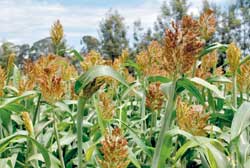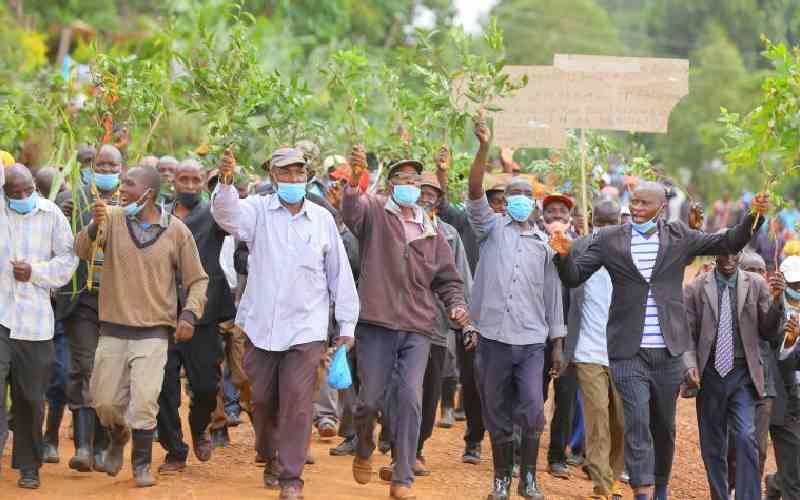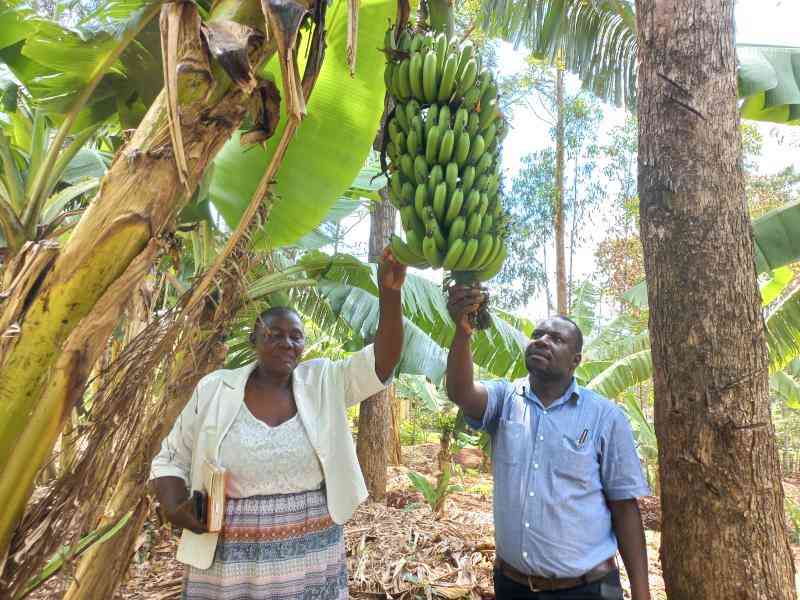When East African Breweries Ltd (EABL) visited Siaya County, last year, on a mission to look for new suppliers of sorghum for beer production, lady luck seemed to have smiled on the farmers. Previously the farmers grew sorghum for subsistence but EABL is now contracting them for commercial farming. This is likely to help reduce rampant poverty in the county.
For several decades, Siaya County was a leading cotton growing zone, but farmers abandoned the crop because of poor prices.
Close to 1,000 farmers drawn from the county turned up for workshop at Siaya Agricultural Training Centre where they were informed that EABL was ready to contract them once they formed groups and consolidated their farms for production of sorghum.
The sorghum varieties suitable for EABL include Gadam, Sila and Kari Mtama, which flower in 40 to 60 days and mature in about three months depending on the altitude. |
A healthy crop of sorghum. [PHOTOS: GEORGE OLWENYA/STANDARD] |
White sorghum has ready market with EABL through its subsidiary East African Maltings Ltd.
Ready market
The EABL sorghum project manager Sylvester Ndeda explained that they would be paying Sh24 per kilo of white sorghum if the company buys the crop.
However, he says those who will deliver produce to the company yard in Nakuru will receive Sh30 per kilo.
Ndeda says the company offers ready market for sorghum and that local farmers should take advantage of the venture to gain from the guaranteed price and market.
“A farmer will require three kilos of sorghum seeds going for around Sh450 to plant in an acre with assurance of good returns because the crops does not require a lot of rain,” he explained.
EABL says it has embarked on an aggressive campaign to promote sorghum growing in Siaya for use as raw materials for its products.
Ndeda and agribusiness manager, Jacob Githigi, said that under the programme, the company was collaborating with the Ministry of Agriculture through the Agricultural Training Institute (ATC) in Siaya to train interested farmers on the best method to produce high quality sorghum.
They explained the company has over the years done research and has been looking for other alternatives to barley. Climate change has adversely affected the traditional barley growing areas, hence the need for alternatives.
Stay informed. Subscribe to our newsletter
Ndeda said the company could no longer rely on barley alone. The situation had led to development of a sorghum variety that could perform just as well as barley.
He said that his company had developed the right variety, which had been grown on a farm at ATC where the locals can learn what is required of them.
“Sorghum can do well just like barley in beer production and if the local residents can embrace the production of this crop, we are willing to contract them,” said Ndeda.
“We are ready to support and even enter into contract with willing farmers whom we shall support to produce the quality crop that we want,” he said.
Ndeda said Siaya County used to produce adequate amount of sorghum but over the years, the locals abandoned it for other cereals for lack of market.
On the other hand, the European Co-operative for Rural Development (Eurocord), collaborating with EABL in the project and was represented by its international co-ordinator, Paul Mudhanjia, who assured the farmers of technical assistance.
Mudhanjia said his company was committed to making sorghum one of the highest paying cash crops in Siaya. The farmers, however, expressed concern over the low pricing demanding to know how EABL reached the price of Sh24 per kilo without first consulting them.
“We cannot buy two kilos of sorghum seeds at Sh300 and then be paid Sh24 per kilo yet we are expected to buy fertilizer and other farm in-puts, which are expensive,” declared Aloice Opany, a farmer from Alego.
Another farmer, John Ochieng’, demanded to know how EABL arrived at the price, saying it was too low. They wanted to know whether the chemicals used to repel birds and insects would affect humans and poultry. Michael Rioba, an expert involved in the research on the bird repellent chemicals for sorghum, explained the compound was safe for human beings.
“Trials on the bird repellent chemical to be sprayed on the crop when rains are over would be carried out soon through the Ministry of Agriculture and there should be no cause for alarm,” Rioba assured farmers. During the occasion, Siaya DC, Boaz Cherutich, said the sorghum project was an opportunity for residents to improve their livelihoods. “We want a serious commitment on this venture. In the past new projects failed because of poor co-ordination and lack of follow-up,” warned Cherutich.
The EABL has also involved other collaborators, including the East African Seed Company, which is coming up with the best seed variety. EABL says farmers stand a chance of harvesting nearly 25 bags of 90kg per hectare in one season.
 The Standard Group Plc is a
multi-media organization with investments in media platforms spanning newspaper
print operations, television, radio broadcasting, digital and online services. The
Standard Group is recognized as a leading multi-media house in Kenya with a key
influence in matters of national and international interest.
The Standard Group Plc is a
multi-media organization with investments in media platforms spanning newspaper
print operations, television, radio broadcasting, digital and online services. The
Standard Group is recognized as a leading multi-media house in Kenya with a key
influence in matters of national and international interest.
 The Standard Group Plc is a
multi-media organization with investments in media platforms spanning newspaper
print operations, television, radio broadcasting, digital and online services. The
Standard Group is recognized as a leading multi-media house in Kenya with a key
influence in matters of national and international interest.
The Standard Group Plc is a
multi-media organization with investments in media platforms spanning newspaper
print operations, television, radio broadcasting, digital and online services. The
Standard Group is recognized as a leading multi-media house in Kenya with a key
influence in matters of national and international interest.









